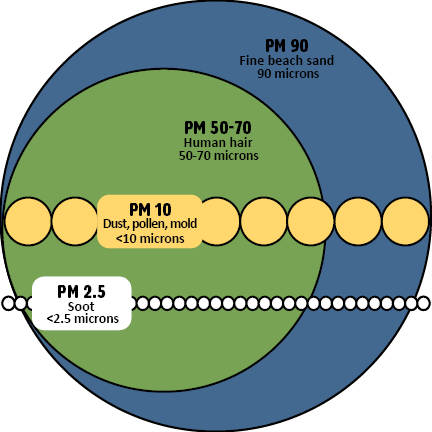Particle pollution in Washington's air
Ecology and local clean air agencies monitor particle pollution in the air to make sure it doesn't reach harmful levels. We work to reduce particle pollution by recommending cleaner wood stoves and reducing outdoor burning when possible. We track particle pollution in current air quality conditions.
Fine particles smaller than a human hair and grain of sand are harmful to your health.
What is particle pollution?
Particle pollution, also called particulate matter (PM), is a mixture of tiny solids or liquid droplets that includes smoke, soot, dirt, and dust floating in the air. Common sources are:
- Wood stoves and fireplaces
- Vehicles
- Dust from construction and agriculture
- Outdoor burning
- Industrial facilities
- Wildfires
When we breathe, our nose or sinuses capture many of the particles in the air before they get to our lungs. However, smaller particles may escape these defenses and move deeper into our lungs, causing health problems. For this reason, Ecology monitors two specific size ranges of small particles:
- PM10 — particles less than 10 micrometers
- PM2.5 — particles less than 2.5 micrometers
Maintaining clean air
Today, all of Washington meets air quality standards for particle pollution, but there are several areas of concern that are being watched closely. To make sure the air continues to meet air quality standards, we and our partners monitor the air at 55 sites using Washington's Air Monitoring Network.
- Twenty-two are in urban areas (the Puget Sound region, Vancouver, Spokane, and Yakima Counties, and the Tri-Cities).
- Nineteen are in small communities outside of urban areas that have local sources of PM2.5 pollution.
- Seven are in agricultural areas and are used to inform agricultural burning decisions.
- Six are in tribal areas. These monitors are run by our tribal partners.
- One is in a natural rural location on the Olympic Peninsula.
Areas of concern for particulate matter
Select >> to view legend or enlarge the map.
Particle pollution is not just a problem for people. Particulates can be carried on the wind, land in streams or lakes, or get into the soil. This causes:
- Streams to become acidic.
- A change in the nutrient balance in coastal water and large river basins.
- Deficiencies in soil nutrients in the soil.
- Damage to forests and crops.
- A change in ecosystem diversity.
Particle pollution affects the airways and lungs, and can cause problems in other parts of your body. It's especially bad for those with chronic heart and lung disease (like asthma, bronchitis, and emphysema), children, and the elderly. It worsens these diseases, which can lead to hospitalization or even early death.
Children are at high risk because their lungs are still growing and they spend more time at high activity levels. Exercise and physical activity cause people to breathe faster and more deeply, taking more particles into their lungs.
Even if you’re healthy, you may experience temporary symptoms, such as irritation of the eyes, nose, throat, and respiratory system.
Related links
Contact information
Matt Kadlec
Toxicologist
matt.kadlec@ecy.wa.gov
360-522-0701


